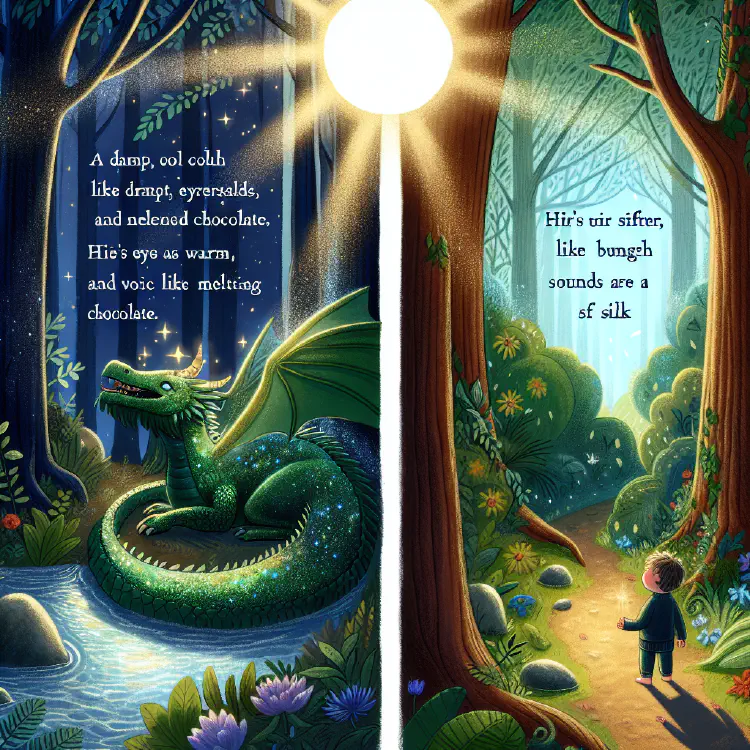How to Use Sensory Language in Bedtime Stories
Sensory language in bedtime stories enhances imagination, vocabulary, comprehension, emotional connection, and relaxation. It vividly describes settings, characters, and actions.
- 4 min read

Bedtime stories have been a cherished tradition for generations, captivating young minds and lulling children into peaceful slumber. As parents, we often find ourselves searching for new and engaging ways to make these nightly tales more enchanting for our little ones. One powerful technique that can transform ordinary bedtime stories into magical experiences is the use of sensory language. By incorporating vivid descriptions that appeal to all five senses, we can create immersive narratives that not only entertain but also stimulate our children’s imagination and cognitive development.
In this comprehensive guide, we’ll explore the art of using sensory language in bedtime stories, providing you with practical tips and examples to enhance your storytelling skills. Whether you’re reading classic fairy tales, reciting short bedtime stories, or crafting your own sleep stories, these techniques will help you create unforgettable moments with your children at bedtime.
Understanding Sensory Language
Before we dive into the specifics of using sensory language in bedtime stories, let’s first understand what it means. Sensory language refers to words and phrases that appeal to our five senses: sight, sound, smell, taste, and touch. By incorporating these sensory details into your storytelling, you create a more vivid and immersive experience for your listeners.
For example, instead of simply saying, “The princess walked through the forest,” you could say, “The princess tiptoed through the lush forest, feeling the soft moss beneath her feet and hearing the gentle rustling of leaves in the breeze.” This description engages multiple senses, making the story more engaging and memorable for your child.
The Benefits of Sensory Language in Bedtime Stories
Using sensory language in bedtime stories for preschoolers and toddlers offers numerous benefits:
Enhanced imagination: Sensory details help children visualize the story more clearly, fostering creativity and imagination.
Improved vocabulary: Introducing new descriptive words expands your child’s vocabulary and language skills.
Better comprehension: Sensory language helps children understand and remember the story more effectively.
Emotional connection: Vivid descriptions can evoke emotions, helping children connect with the characters and plot on a deeper level.
Relaxation: Soothing sensory language can create a calming atmosphere, perfect for winding down before sleep.
Now that we understand the importance of sensory language, let’s explore how to incorporate it into various aspects of bedtime stories for kids.
Setting the Scene
One of the most effective ways to use sensory language in bedtime stories is when describing the setting. Whether it’s a magical forest, a cozy cottage, or a bustling city, rich sensory details can transport your child into the world of the story.
Example: “As Little Red Riding Hood stepped into the forest, she felt the cool, damp earth beneath her feet. The air was filled with the sweet scent of pine needles, and sunlight dappled the forest floor through the thick canopy of leaves above. In the distance, she could hear the gentle babbling of a brook and the melodious songs of forest birds.”
This description engages multiple senses, allowing your child to imagine themselves in the forest alongside Little Red Riding Hood.
Describing Characters
Bring your characters to life by using sensory language to describe their appearance, movements, and personalities. This helps children form a stronger connection with the story’s protagonists and antagonists.
Example: “The friendly dragon had scales that shimmered like polished emeralds in the sunlight. His eyes were as warm as melted chocolate, and when he spoke, his voice rumbled like distant thunder. The dragon’s wings were soft as silk, and he smelled faintly of cinnamon and smoke.”
This description appeals to sight, sound, touch, and smell, creating a vivid image of the dragon in your child’s mind.
Enhancing Action Scenes
Even in short bedtime stories, action scenes can benefit from sensory language. Use descriptive words to make these moments more exciting and engaging for your young audience.
Example: “The brave knight charged towards the castle gates, his armor clanking with each step. The ground trembled beneath his feet as he ran, and the air filled with the acrid smell of smoke from the dragon’s fiery breath. He could taste the metallic tang of fear on his tongue, but pressed on, determined to save the princess.”
This description engages all five senses, making the action scene more thrilling and immersive.
